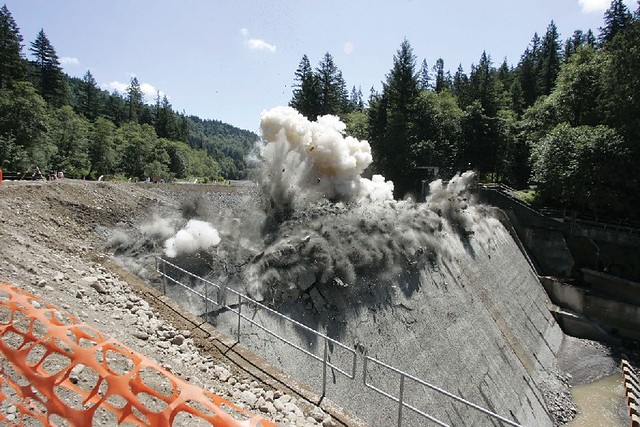The tide has shifted on dams. Once a monument to our engineering prowess, there’s now widespread acknowledgment that dam-building comes with a long list of harms. Some of those can be reversed, as shown by the 1,200 dam removals in the past 20 years.
But the future of our existing dams, including 2,500 hydroelectric facilities, is a complicated issue in the age of climate change. Dams have altered river flows, changed aquatic habitat, decimated fish populations, and curtailed cultural and treaty resources for tribes. But does the low-carbon power dams produce have a role in our energy transition?
That’s a question some environmental groups and the hydropower industry have been discussing for the past few years, and it’s resulted in a joint effort to work together on increasing the renewable energy potential of existing dams while helping to minimize their environmental harm.
It’s just one effort to rethink the future of dams. Here’s what else to keep in mind:

1. Climate change will necessitate a reckoning.
We’re already seeing more extreme weather, bigger storms and more severe droughts. And the effect of this is visible in our reservoirs. The Colorado River’s two biggest reservoirs now sit half empty after a two-decade drought, prompting calls to tear one down. California grappled with the other side of the problem in 2017 when quickly rising waters nearly caused a failure at Oroville Dam — the tallest in the country — and a public safety disaster.
2. Dam removal can restore rivers.
More than 1,600 dams have been removed in the United States since 1912. With each removal scientists are learning more about how river ecosystems respond. The results are encouraging.
For example, the removal of the Edwards Dam on Maine’s Kennebec River 20 years ago and the subsequent removal of the Fort Halifax Dam farther upstream have helped fish populations rebound and improved water quality. Sturgeon, striped bass, rainbow smelt and other sea-run species gained access to their historic habitat. Alewife populations returning to spawn jumped from 78,000 in 1999 to 5.5 million in 2018.
In Washington the sea-to-headwaters restoration of the Elwha River, with the removal of two dams completed in 2014, helped restore the estuary and has already seen nearly extinct summer steelhead return and rising numbers of Chinook salmon.
3. Watersheds are interconnected.
Removing one dam can help. But understanding and addressing interconnected problems in an entire basin is even better.
A collaborative effort to look at the whole Penobscot River basin in Maine resulted in the removal of multiple dams and the retrofitting of others. The end result was more than 2,000 miles of river opened up for salmon and other fish species and an improvement in hydropower generation.
In California an effort to remove more than 80 small dams in the Cleveland National Forest is expected to benefit native aquatic species throughout the watershed, including endangered Southern California steelhead.
4. It’s about more than fish.
Taking down dams can revitalize urban waterfronts, create recreational opportunities and drive economic growth. It can also make communities safer.
Public safety concerns were at the center of dam-removal discussions, like at Bloede Dam on Maryland’s Patapsco River, where nine people drowned. Dated and derelict dams that fail can also threaten lives and property, as those downstream from Michigan’s Edenville Dam found out earlier this year.
5. We have a climate crisis and a biodiversity crisis.
The unlikely alliance of environmental groups like American Rivers, which has worked to remove more than 200 dams, and hydroelectric companies shows the challenges of this moment.
Do we take down dams that provide hydroelectric power but critically endanger species? It’s an issue that’s been debated on the Snake River for years. And how do we ramp up clean energy production without further endangering wildlife and ecosystems? That’s something that states in the Northeast now find themselves contemplating.
Figuring all that out is likely to involve complicated tradeoffs, hard conversations and more unlikely alliances.
It will also necessitate more reporting to understand it all. At The Revelator we’ll continue covering the complexities of dam issues. And if you’ve missed our previous reporting or want to know more about these issues, here are links to our most important articles and commentaries.
Dam Removal
How Removing One Maine Dam 20 Years Ago Changed Everything
The Elwha’s Living Laboratory: Lessons From the World’s Largest Dam-removal Project
200 Years Ago My Family Built a Dam — Now My Organization Is Tearing It Down
A Dam Comes Down — and Tribes, Cities, Salmon and Orcas Could All Benefit
Boom: Removing 81 Dams Is Transforming This California Watershed
Endgame Looms for New England’s Great River
Untangling the Politics of Dam Removal
Four Exciting Dam-removal Projects to Watch
Climate Change and Energy
Promise or Peril? Importing Hydropower to Fuel the Clean Energy Transition
Is New England’s Biggest Renewable Energy Project Really a Win for the Climate?
‘Science Be Dammed’: Learning From History’s Mistake on the Colorado River
Let Rivers Flood: Communities Adopt New Strategies for Resilience
Wildlife
What Would It Take to Save Southern Resident Killer Whales From Extinction?
To Restore Salmon, Think Like a Beaver
How Saving Southern California’s Steelhead Trout Could Also Help the State’s Watersheds
Indigenous Communities
Dam Lies: Despite Promises, an Indigenous Community’s Land Is Flooded
Hundreds of Planned Dams Threaten Central America’s Last Free-flowing Rivers
![]()


